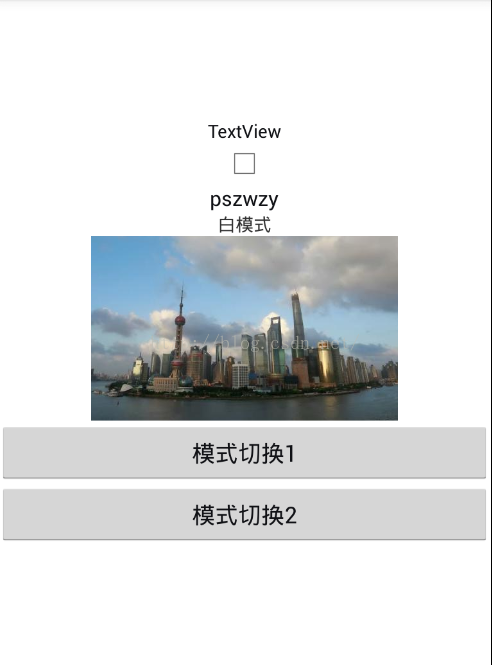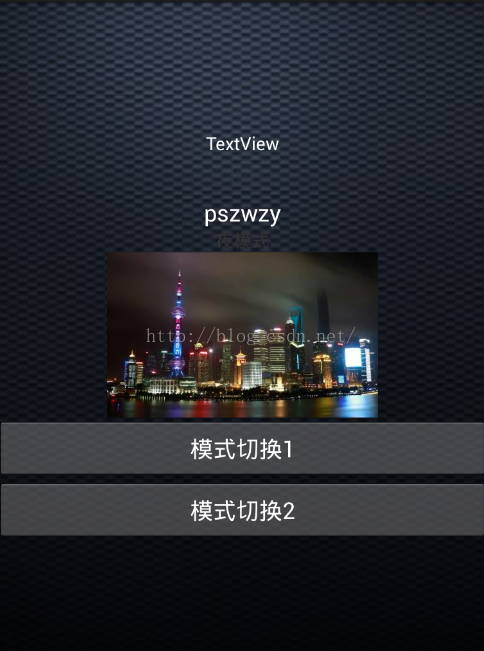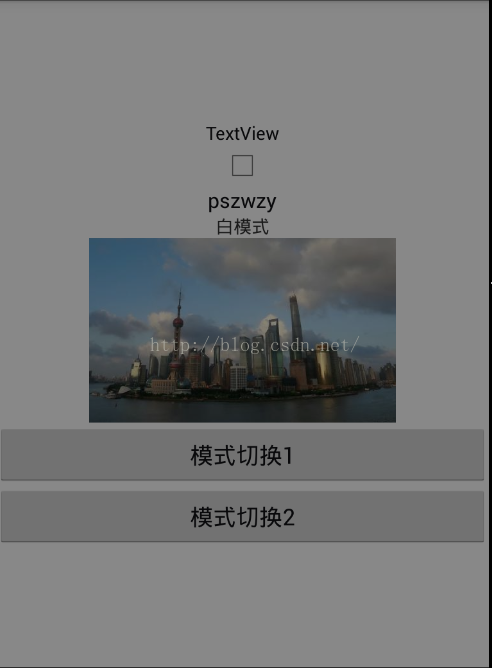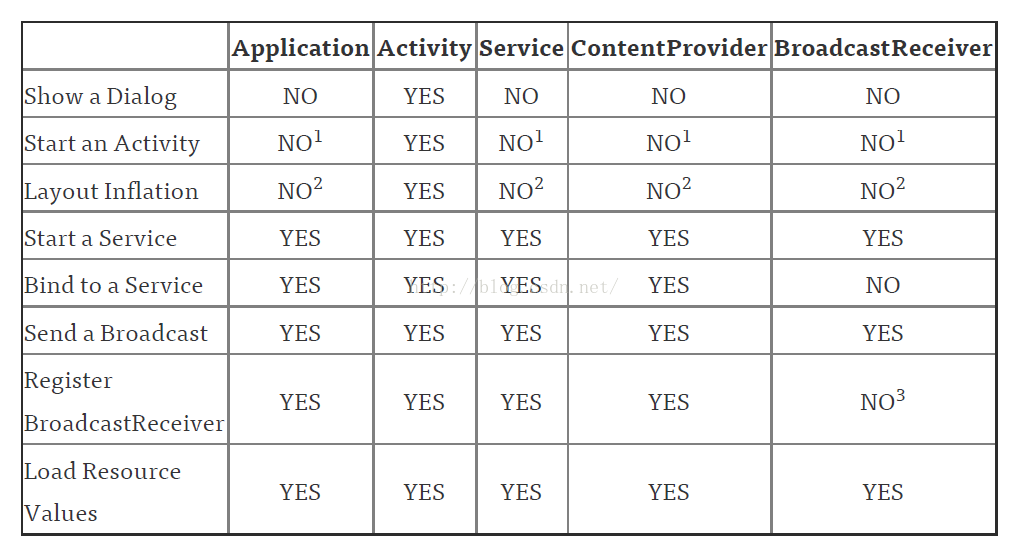編輯:關於Android編程
優點:正兒八經的夜間模式,配色看著舒服
缺點:規模較大的應用,需要隨theme變化的屬性會很多,都需要逐一定義,有點麻煩,另外一個缺點是要使得新theme生效,一般需要restartActivity來切換UI,會導致切換主題時界面閃爍
核心思路:自定義一個顏色屬性名 A,A在日間和夜間模式下都有具體的顏色代碼,頁面布局文件只管引用A,至於是日間還是夜間,由後台主題決定。
附上一二中方法的圖
 (原圖)
(原圖) (第一種實現)
(第一種實現) (第二種實現)
(第二種實現)
好,下面來講講具體的實現步驟,本環節使用的開發環境是Eclipse demo地址http://www.oschina.net/code/snippet_2702417_55892
attrs.xml(聲明屬性的類型,布局xml中用) reference可以使用系統的資源ID,比如R.color.gray; color可以直接使用#ffffff顏色代碼
<attr name="colorValue" format="color" />
<attr name="floatValue" format="float" />
<attr name="integerValue" format="integer" />
<attr name="booleanValue" format="boolean" />
<attr name="dimensionValue" format="dimension" />
<attr name="stringValue" format="string" />
<attr name="referenceValue" format="color|reference" />
<attr name="imageValue" format="reference"/>
<attr name="curVisibility">
<!-- 相當於View的Visiblity -->
<enum name="show" value="0" />
<!-- Not displayed, but taken into account during layout (space is left for it).相當於View的unVisiblity -->
<enum name="inshow" value="1" />
<!-- Completely hidden, as if the view had not been added.相當於View的GONE -->
<enum name="hide" value="2" />
</attr>
colors.xml(調色板,集中管理顏色hex)遵循優秀格式規范,即調色板模式,避免使用btn1,btn2,fontTitle,fontText之類的顏色名。
<?xml version="1.0" encoding="utf-8"?> <resources> <color name="title">#101115</color> <color name="night_title">#FFFFFF</color> </resources>
string.xml
<string name="app_name">dayandNight</string> <string name="hello_world">Hello world!</string> <string name="action_settings">白模式</string> <string name="night_action_settings">夜模式</string>
styles.xml(日間、夜間主題)
<resources>
<style name="AppBaseTheme" parent="android:Theme.Light">
<!--
Theme customizations available in newer API levels can go in
res/values-vXX/styles.xml, while customizations related to
backward-compatibility can go here.
-->
</style>
<!-- Application theme. -->
<style name="AppTheme" parent="AppBaseTheme">
<!-- All customizations that are NOT specific to a particular API-level can go here. -->
</style>
<style name="DayTheme" parent="AppTheme">
<item name="colorValue">@color/title</item>
<item name="floatValue">0.35</item>
<item name="integerValue">33</item>
<item name="booleanValue">true</item>
<item name="dimensionValue">16dp</item>
<!-- 如果string類型不是填的引用而是直接放一個字符串,在布局文件中使用正常,但代碼裡獲取的就有問題 -->
<item name="stringValue">@string/action_settings</item>
<item name="referenceValue">@drawable/bg</item>
<item name="imageValue">@drawable/day</item>
<item name="curVisibility">show</item>
</style>
<style name="NightTheme" parent="AppTheme">
<item name="colorValue">@color/night_title</item>
<item name="floatValue">1.44</item>
<item name="integerValue">55</item>
<item name="booleanValue">false</item>
<item name="dimensionValue">18sp</item>
<item name="stringValue">@string/night_action_settings</item>
<item name="referenceValue">@drawable/night_bg</item>
<item name="imageValue">@drawable/night</item>
<item name="curVisibility">hide</item>
</style>
</resources>
protected void onCreate(Bundle savedInstanceState) {
super.onCreate(savedInstanceState);
if(MyApp.isLightMode()){
this.setTheme(R.style.NightTheme);
}else{
this.setTheme(R.style.DayTheme);
}
setContentView(R.layout.activity_one);
}
public void onClick(View view){
MyApp.setIslightMode(!MyApp.isLightMode());
recreate();
}
xml的布局:
<?xml version="1.0" encoding="utf-8"?>
<LinearLayout xmlns:android="http://schemas.android.com/apk/res/android"
android:layout_width="match_parent"
android:layout_height="match_parent"
android:background="?attr/referenceValue"
android:orientation="vertical"
android:gravity="center" >
<TextView
android:id="@+id/setting_Color"
android:layout_width="wrap_content"
android:layout_height="wrap_content"
android:text="TextView"
android:textColor="?attr/colorValue" />
<CheckBox
android:id="@+id/setting_show_answer_switch"
android:layout_width="wrap_content"
android:layout_height="wrap_content"
android:checked="?attr/booleanValue" />
<TextView
android:id="@+id/setting_Title"
android:layout_width="wrap_content"
android:layout_height="wrap_content"
android:text="pszwzy"
android:textColor="?attr/colorValue"
android:textSize="?attr/dimensionValue" />
<TextView
android:id="@+id/setting_Text"
android:layout_width="wrap_content"
android:layout_height="wrap_content"
android:text="?attr/stringValue" />
<ImageView
android:id="@+id/setting_Image"
android:layout_width="wrap_content"
android:layout_height="wrap_content"
android:src="?attr/imageValue" />
<View
android:id="@+id/setting_line"
android:layout_width="match_parent"
android:layout_height="1dp"
android:visibility="?attr/curVisibility" />
<Button
android:onClick="onClick"
android:layout_width="match_parent"
android:layout_height="wrap_content"
android:text="模式切換"
android:textColor="?attr/colorValue"
/>
</LinearLayout>
注:遇到放回activity閃屏的問題可以
(1)在BaseActivity中創建下面的方法
public static void updateTheme(Activity activity,isNight)
{
MyApp.setNightMode(isNight);
activity.recreate();
}
//第二中方式,只是提供一種思路,邏輯沒有去實習
public void onClickT(View view){
LayoutParams mNightViewParam = new LayoutParams(
LayoutParams.TYPE_APPLICATION,
LayoutParams.FLAG_NOT_TOUCHABLE | LayoutParams.FLAG_NOT_FOCUSABLE,
PixelFormat.TRANSPARENT);
WindowManager mWindowManager = (WindowManager) getSystemService(Context.WINDOW_SERVICE);
View mNightView = new View(this);
mWindowManager.addView(mNightView, mNightViewParam);
mNightView.setBackgroundResource(R.color.night_mask);
}
先看下BaseActivity
public abstract class BaseActivity extends Activity {
protected int skin;
public Context mContext;
SharedPreferences sp;
@Override
protected void onCreate(Bundle savedInstanceState) {
<span style="white-space:pre"> </span>setThemeMode(getSkinTypeValue());
<span style="white-space:pre"> </span>super.onCreate(savedInstanceState);
<span style="white-space:pre"> </span>init();
<span style="white-space:pre"> </span>}
<span style="white-space:pre"> </span>public abstract void init();
<span style="white-space:pre"> </span>protected void setThemeMode(SkinType skinType) {
<span style="white-space:pre"> </span> switch (skinType) {
<span style="white-space:pre"> </span> case Light:
<span style="white-space:pre"> </span>setTheme(R.style.AppTheme_Light);
<span style="white-space:pre"> </span> break;
<span style="white-space:pre"> </span> case Night:
<span style="white-space:pre"> </span>setTheme(R.style.AppTheme_Night);
<span style="white-space:pre"> </span> break;
<span style="white-space:pre"> </span> default:
<span style="white-space:pre"> </span>setTheme(R.style.AppTheme_Light);
<span style="white-space:pre"> </span> break;
<span style="white-space:pre"> </span>}
}
//獲取用戶選取的模式
protected SkinType getSkinTypeValue() {
<span style="white-space:pre"> </span>if (sp == null) {
<span style="white-space:pre"> </span>sp = getSharedPreferences("AppSkinType", Context.MODE_PRIVATE);
<span style="white-space:pre"> </span>}
<span style="white-space:pre"> </span>int i = sp.getInt("AppSkinTypeValue", 0);
<span style="white-space:pre"> </span>switch (i) {
<span style="white-space:pre"> </span> case 0:
<span style="white-space:pre"> </span>return SkinType.Light;
case 1:
<span style="white-space:pre"> </span>return SkinType.Night;
<span style="white-space:pre"> </span> default:
<span style="white-space:pre"> </span> break;
<span style="white-space:pre"> </span>}
<span style="white-space:pre"> </span>return SkinType.Light;
}
//保存用戶是選取的模式
public void saveSkinValue(int skin) {
<span style="white-space:pre"> </span>if (sp == null) {
<span style="white-space:pre"> </span>sp = getSharedPreferences("AppSkinType", Context.MODE_PRIVATE);
<span style="white-space:pre"> </span>}
<span style="white-space:pre"> </span>Editor editor = sp.edit();
<span style="white-space:pre"> </span>editor.putInt("AppSkinTypeValue", skin);
<span style="white-space:pre"> </span>editor.commit();
}
在看下第一個activity的使用的
public class MainActivity extends BaseActivity {
private CheckBox cbSetting;
private Button btnForward;
private TextView tv_title;
private View llNight;
@Override
public void init() {
setContentView(R.layout.activity_main);
llNight = findViewById(R.id.ll_night);
tv_title = (TextView) findViewById(R.id.tv_title);
btnForward = (Button) findViewById(R.id.forward);
cbSetting = (CheckBox) findViewById(R.id.cb_setting);
cbSetting.setOnCheckedChangeListener(new OnCheckedChangeListener() {
@Override
public void onCheckedChanged(CompoundButton buttonView, boolean isChecked) {
if (isChecked) {
// 夜間模式
saveSkinValue(1);
setTheme(R.style.AppTheme_Night);//防止getTheme()取出來的值是創建時候得值
initView();
} else {
// 白天模式
saveSkinValue(0);
setTheme(R.style.AppTheme_Light);//防止getTheme()取出來的值是創建時候得值
initView();
}
}
});
btnForward.setOnClickListener(new View.OnClickListener() {
@Override
public void onClick(View v) {
Intent intent = new Intent(MainActivity.this,SecondActivity.class);
startActivity(intent);
}
});
}
//改變模式後手動修改UI,不然出現閃屏
private void initView(){
<span style="color:#ff6666;">TypedValue typedValue = new TypedValue();
Theme theme = getTheme();
theme.resolveAttribute(R.attr.gray_3_double, typedValue, true);
btnForward.setTextColor(getResources().getColor(typedValue.resourceId));
tv_title.setTextColor(getResources().getColor(typedValue.resourceId));
theme.resolveAttribute(R.attr.source_bg, typedValue, true);
llNight.setBackgroundDrawable(getResources().getDrawable(typedValue.resourceId));</span>
}
}
大體就是這樣實現
 Android編程實現ViewPager多頁面滑動切換及動畫效果的方法
Android編程實現ViewPager多頁面滑動切換及動畫效果的方法
本文實例講述了Android編程實現ViewPager多頁面滑動切換及動畫效果的方法。分享給大家供大家參考,具體如下:一、首先,我們來看一下效果圖,這是新浪微博的Tab滑
 自定義AvatarImageView滿足你所有頭像顯示需求
自定義AvatarImageView滿足你所有頭像顯示需求
1.PorterDuffXfermode這是由Tomas Proter和 Tom Duff命名的圖像轉換模式,它有16個枚舉值來控制Canvas上 上下兩個圖層的交互(先
 android代碼審查工具---lint工具的使用
android代碼審查工具---lint工具的使用
轉載請著名出處:http://blog.csdn.net/lijunhuayc 搞了這麼久android我居然不知道lint工具是干啥的,雖然每次在eclip
 android中Context的應用總結
android中Context的應用總結
概述作為一名Android開發人員,每天使用最多的類中,恐怕Context可以排的上一號了。因為Context對象在我們的項目中實在是太常見了,我們在加載資源,啟動Act